Tag: educator
CONNECT Countdown – Region 2

As State Administrator Clay Long announced on May 3, the Idaho Division of Career Technical Education will be moving from a single summer conference to three rotating regional conferences in 2022.
You can register for any event, space permitting, regardless of where you live or work. And no matter which event you attend, the registration fee and division program will be identical for all three conferences.* Choose the event that works best for you and save the date:
| Dates | Schedule |
| July 13-16, 2022 | College of Southern Idaho |
| Aug. 3-6, 2022 | College of Eastern Idaho |
| Sept. 21-24, 2022 | Lewis-Clark State College |
CONNECT Countdown – Region 6

As State Administrator Clay Long announced on May 3, the Idaho Division of Career Technical Education will be moving from a single summer conference to three rotating regional conferences in 2022.
You can register for any event, space permitting, regardless of where you live or work. And no matter which event you attend, the registration fee and division program will be identical for all three conferences.* Choose the event that works best for you and save the date:
| Dates | Schedule |
| July 13-16, 2022 | College of Southern Idaho |
| Aug. 3-6, 2022 | College of Eastern Idaho |
| Sept. 21-24, 2022 | Lewis-Clark State College |
CONNECT Countdown – Region 4

As State Administrator Clay Long announced on May 3, the Idaho Division of Career Technical Education will be moving from a single summer conference to three rotating regional conferences in 2022.
You can register for any event, space permitting, regardless of where you live or work. And no matter which event you attend, the registration fee and division program will be identical for all three conferences.* Choose the event that works best for you and save the date:
| Dates | Schedule |
| July 13-16, 2022 | College of Southern Idaho |
| Aug. 3-6, 2022 | College of Eastern Idaho |
| Sept. 21-24, 2022 | Lewis-Clark State College |
Leadership Institute helps business educator achieve career goal, promote CTE
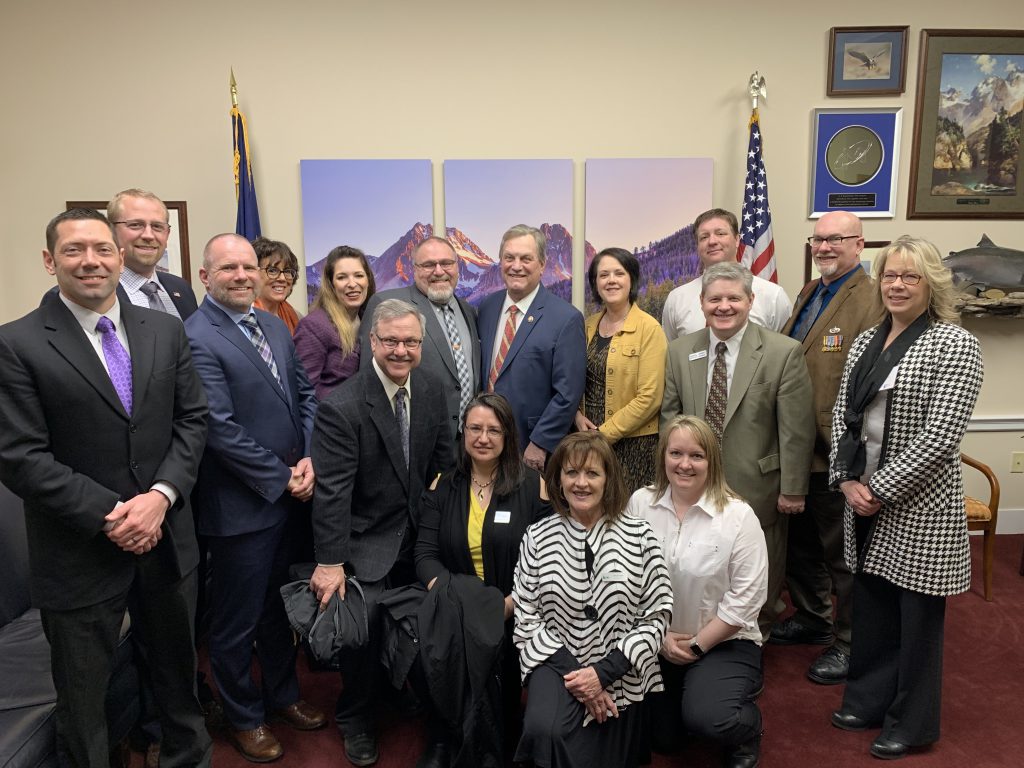

Twelve years ago, Shelley High School business educator Pam Kantack was a big proponent of every student needing a college degree—until she saw what CTE programs were doing for students.
“I didn’t really understand what CTE was until I got into the schools,” said Kantack. “There are all these different pathways that allow students to explore what they love without spending a lot of money to get the training they need to enter the workforce.”
Since then, Kantack has been an ardent supporter of CTE programs and was eager to help more administrators, teachers, parents, and students see their value. So when she received an email from the Idaho Division of Career Technical Education (IDCTE) promoting its Leadership Institute program in 2017, she thought it would be a good way to champion CTE—and achieve her goal of becoming an administrator.
“I didn’t think I would be accepted, but I thought our school could benefit from more leadership on the CTE side, so I applied anyway,” said Kantack.
To her surprise, she was accepted. Over the next three years, Kantack balanced her responsibilities as a business educator with the requirements of the Leadership Institute program, which included attending seminars on state and national CTE policy, completing the Idaho Association of School Administrators Project Leadership program, creating a professional development plan to obtain an Idaho CTE administrator’s endorsement, and attending state and national meetings to expand her knowledge of CTE. Kantack said the state and national policy initiative was the most helpful of all the opportunities Leadership Institute provided.
“My overall goal was to make CTE a priority in our district, but I didn’t know how or who to talk to,” said Kantack. “Through Leadership Institute, I gained the confidence to talk to legislators, tell them what was going on in our classrooms, and ask for their support.”
Pam Kantack
Though the time commitment was at times intense, Kantack says the most challenging thing about the program was developing confidence in her leadership skills.
“It probably took until the second year of the program for me to realize I had the capability to be a leader, accept that power, and move forward with it,” said Kantack. “It was truly life-changing. I didn’t consider myself a leader before Leadership Institute, but my leadership qualities have tripled since I started.”
Kantack used her newfound confidence to ask her administration if she could teach part-time and spend the rest of her time serving as the school’s CTE administrator; he agreed. Kantack has also used what she learned through Leadership Institute in her new role as president-elect of Career Technical Educators of Idaho, the professional association for career technical educators, administrators, and stakeholders in Idaho.
Now that Kantack has graduated from Leadership Institute, she’s more driven than ever to elevate the perception of CTE and advocate for a career technical school in the Shelley School District. “Now everybody in my school knows what CTE means, and they respect it,” said Kantack. “When people see what’s going on and what we’re producing, it’s making a difference.”
Relationships, certifications lead to 100% job placement for Diesel Technology program
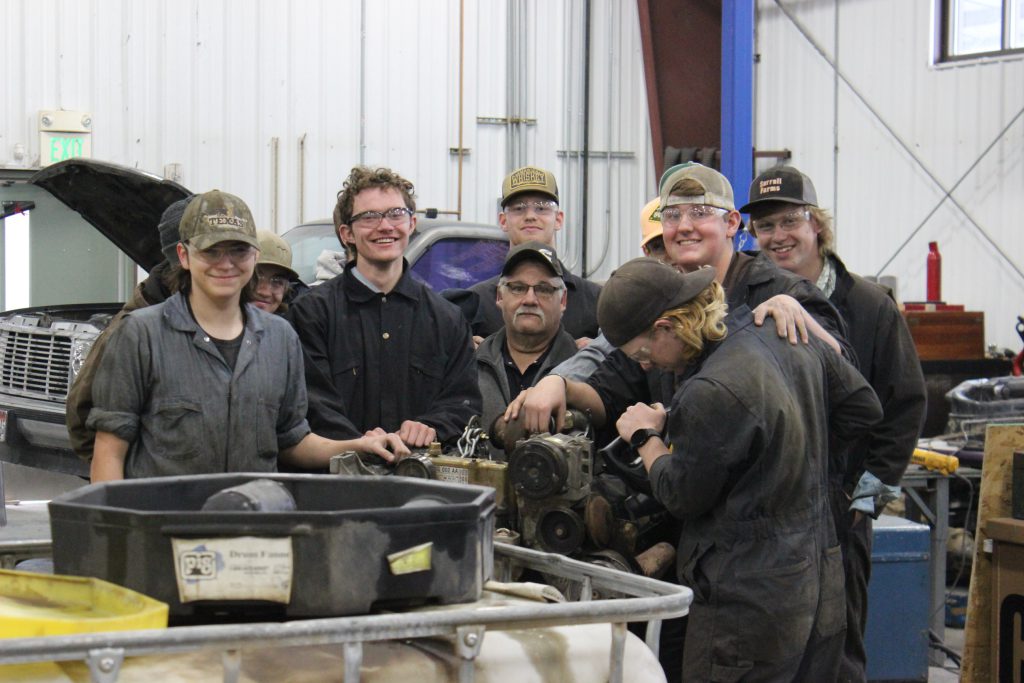
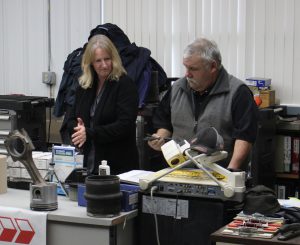
Diesel mechanic John Montana knows firsthand how difficult it is to find skilled workers, especially for in-demand professions. In fact, his inability to find and hire qualified workers is what drove him to become a teacher in the first place.
“I couldn’t hire decent help,” said Montana. “I was training new employees on the job anyway for about 10 or 11 years, so when Canyon-Owyhee School Service Agency’s (COSSA) old diesel technology teacher retired in 1999, I figured I’d give teaching a try.”
Though Montana started teaching part-time, he soon discovered he loved working with the kids and was teaching full-time by his second year. In the two decades since, Montana has cultivated relationships with about a dozen farm implement companies, several of whom employ Montana’s former students. These relationships benefit students and businesses alike—in many ways.
First, industry partners like John Deere, Kenworth, Peterbilt, Agri-Service, Caterpillar, and Mountain View Equipment are always willing to drop off equipment and provide opportunities for students to develop their skills via job shadowing and internships. They know they’ll be able to hire skilled workers from the talent pool Montana produces, so they’re willing to help his students develop career readiness skills by conducting mock job interviews or reviewing student resumes.
Second, industry partners provide additional feedback about new workers’ skills and what needs to change or be updated in the program to prepare students for their careers. This also helps ensure Montana himself stays current.
“That’s one positive thing about these kids staying local; they’re an excellent reference for me,” said Montana. “I don’t get to work out in the field like I used to, so I bounce stuff off my former students all the time. I know I can call any of them up and ask, ‘What have you run across?’ or ‘We’ve got this truck in here that’s doing this and this; have you seen anything like that?’”
Most importantly, these relationships have resulted in 100% job placement over the past 14 years.
“Because the program teaches to NATEF standards, students can earn industry-recognized certifications in electrical engines, transmissions, engine repair, brakes, and preventative maintenance,” said Montana. “Students can also earn their OSHA 10 card and SP2 Safety and Pollution Prevention training certificates while still in high school. That means students may not need a lot of on-the-job training after they graduate.”
This is a huge advantage to not only students but their employers as well.
“If there are 50 applicants for a job and you have these certificates—especially the safety certificates—you’ll move to the top of the list because it cuts down on the number of hours an employer has to train you, and you can get right to work,” said Montana.
Patricia Frahm
COSSA’s principal, Patricia Frahm, says the importance of this foundation can’t be overstated. “If a student walks out of a CTE program with these certifications, they can walk into a job immediately, and if they decide to go on to college, it gives them a skill they can use to pay their way through school,” said Frahm. “They also learn work ethic and accountability in the process—things that can help them for the rest of their lives.”
High school fire program helps fill workforce need in the Portneuf Valley


When veteran firefighter Mark Brood agreed to do a presentation on volunteer firefighting at Pocatello High School in 2015, he had no idea where it would lead.
“Right after my presentation, I got hauled down to the principal’s office,” said Brood. “Lisa (Delonas) told me they had a first responder academy, but they didn’t have an EMT or a fire component. She asked if I would be interested in helping get it up and running. I guess it was a case of being in the right place at the right time.”
In his 29 years in the fire service, Brood had trained a lot of new firefighters, so he was up for the challenge. As an active fire chief with the North Bannock Fire Department, he could also rely on his industry connections to establish the program. Fortunately, Brood received much support from Superintendent Dr. Douglas Howell, the school board, the school district, and the fire community. Throughout Eastern Idaho, donations poured in, including turnouts (the protective gear worn by firefighters) from the city of Chubbuck, various equipment from the city of Pocatello, and fire hoses from the Idaho Falls Fire Department.
One of the reasons the community rallied around the program is the growing need for first responders and the fact that so many small communities in Idaho rely on the service of volunteer firefighters.
“In these communities, shopkeepers, farmers, ranchers, and neighbors just drop whatever they’re doing when the bell rings and hop on the fire truck as it goes by,” said Rhonda Naftz, career technical education administrator for School District No. 25. “It’s like training them to fulfill their civic duty. This CTE program can bring this service to smaller communities.”
The Pocatello/Chubbuck School District renovated a building to house the career technical school program and purchased a retired fire engine using Perkins funds. Brood built all the other props necessary for the program, so it was ready to accept its first students when the 2016-2017 school year began.
“When you walk into the classroom, I wanted it to feel like you were walking into a fire department,” said Brood. “I teach to International Fire Service Accreditation Congress (IFSAC) standards. We start each class with the textbook and didactics, then get into the skill work. We try to do everything just like in a fire department, including breaking the class into three platoons, each with its own captain.”
Every day, Brood’s students go through all the equipment to make sure it’s ready and even participate in timed drills, like putting on all their gear in under three minutes. Just like in a real fire department, they have competitions to see which platoon finishes first. Students also can assist on calls, do a ride-along and practice practical skills towards the end of the program.
“The need for first responders is only going to increase as Idaho’s population grows, and this program helps to fill some of that need,” said Brood. “Now that we’re six years into the program, we’re starting to get success stories, which is really cool. I love it when you see a student achieve their goal, or even better, achieve something they didn’t think they could do.”
Mark Brood
Everything about the program is designed to ensure students are prepared to be first responders upon graduation. For example, Brood follows the Candidate Physical Ability Test curriculum, the recognized standard for measuring an individual’s ability to handle the physical demands of being a firefighter. Also, all students earn the National Heart Association CPR for Healthcare Providers certification. Finally, most students take the firefighting course as juniors and the EMT course as seniors because most fire departments require EMT certification.
Upon completion, students have received training to earn their IFSAC and National Wildfire Coordinating Group certifications in Hazardous Materials, Extrication, and Wildland Fire. Students still have to take the industry test, which involves the use of a specialized burn trailer. Students need to be 18 and graduated from high school to complete this component; this activity is usually completed the summer following graduation.
As proof of Brood’s students’ achievements, the SkillsUSA chapter he advises swept the podium during the 2019* state competition. After graduation, many of the students begin their careers with municipal or volunteer fire departments, the Bureau of Land Management, or the U.S. Forest Service, and one student went on to graduate from the Idaho Police Officer Standards Training.
LCSC grad takes over Collision Repair Technology program
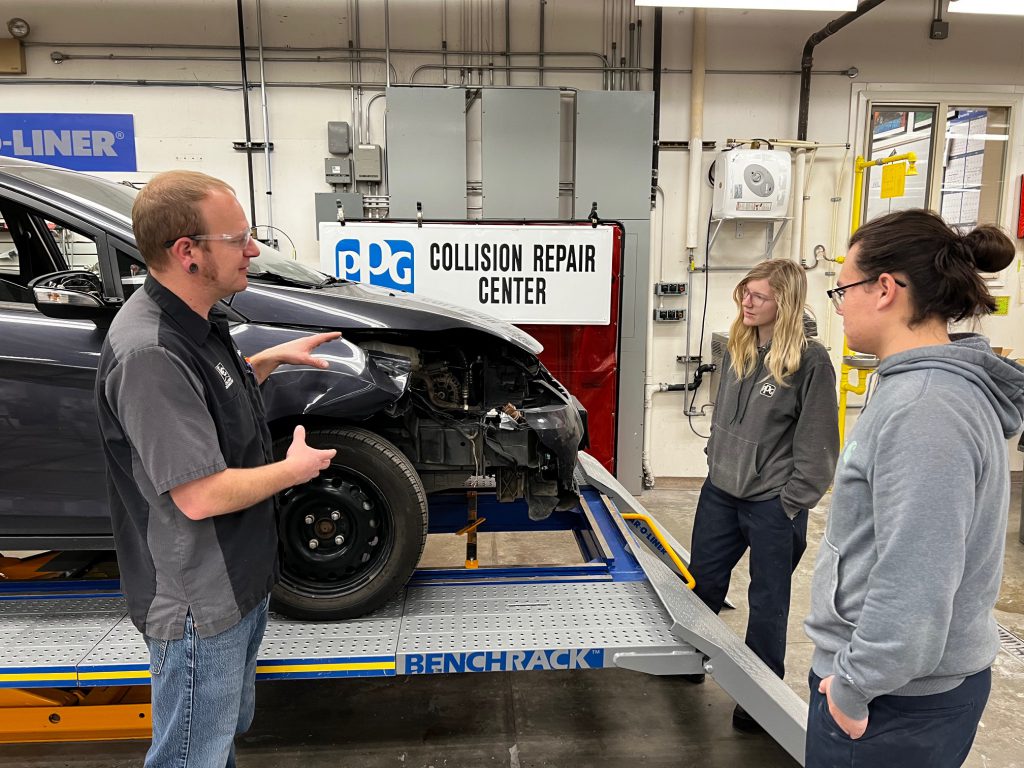

Growing up in the unincorporated town of Laclede, Idaho, Luke Thomas didn’t know what he wanted to do after high school—but he did know he loved working on cars.
“We had a neighbor who worked on cars, and he helped me restore my first vehicle,” said Thomas.
From then on, Thomas was hooked. A family friend who taught at Lewis-Clark State College (LCSC) recommended its two-year Collision Repair Technology program. The program’s reputation, hands-on application, small class size, and one-on-one time with the instructor all appealed to Thomas, who graduated with an Associate of Applied Science in 2008.
After graduation, Thomas’ career was humming along. He had his own repair shop and worked on custom restorations, but he wanted to explore a different facet of the industry. Around that time, Thomas’ professor, Clarence Griffin, decided to transition to teaching part-time, so Thomas saw an opportunity to teach in the same program from which he graduated.
“I was ready for a change and the opportunity to teach the collision program arose at the right time,” said Thomas. “It sounded like a fun way to change things up and help make a difference in the industry.”
During his first three years teaching, Thomas was grateful to be teaching alongside Griffin. And for the most part, Thomas kept the program the same as when he completed it. During the first year, core instruction is provided, and during the second year, students receive in-depth instruction in more complex systems and hands-on training in mock and customer projects.
“Because it’s a two-year program, students can go beyond just learning metal straightening or crash repairs,” said Thomas. “That means we can focus on more advanced skills, and they can get exposure to more facets of the collision repair industry. They’re qualified for a broad spectrum of industry segments by the end of the program, including some outside the collision field, like aviation refinishing, boat manufacturing refinishing, heavy trucks collision repair, custom cars, and hot rods.”
Luke Thomas
A major component of the program is completing an eight-week internship with a local shop. Many students have jobs lined up after graduation at the shop where they completed their internship, which many keep until they decide to move on. The internship allows employers to tap into a talent pipeline to fill their needed positions, which Thomas says translates into more support for the program. Body shop owners have donated vehicles, parts, and uniforms or provided scholarships for the students, and vendors will come in for demonstrations or product training.
Six years later, Thomas has found what he was looking for as a career technical educator. Teaching gave him the freedom to continue running his repair shop and custom restoration business while having more time to pursue other interests. It’s also given him a more holistic perspective of the industry he loves, deepening his appreciation for it.
Above all, Thomas says teaching has allowed him to share his passion with others. “I like seeing someone make something of themselves,” said Thomas. “It takes a lot of work to complete the two-year program, and it’s very rewarding to see a student who completed the program working in the industry and enjoying it.”
HVAC program provides seamless transition from secondary to postsecondary

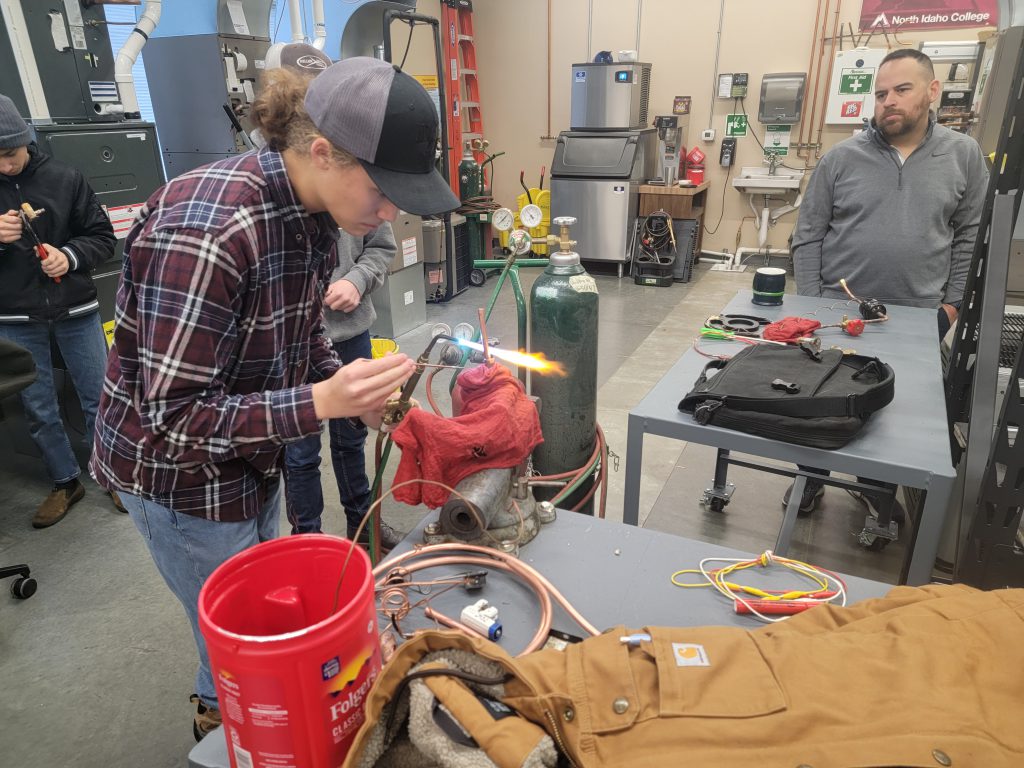
The week before the fall 2017 semester began, Sean Sater received a call from the Trades and Industry Division Chair at North Idaho College (NIC), Doug Anderson. Anderson wondered if Sater would be willing to teach the heating, ventilation, and air conditioning technician (HVAC) class; if Sater said no, the program would be shut down.
Fortunately, Sater, who has 22 years of experience in the field, knew firsthand how much the Coeur d’Alene-Spokane area needed well-trained HVAC technicians. He’d also considered cutting back his hours at HollisterStier, where he worked as a consultant, so he agreed.
“I thought it was a great way to pay it forward and help the next generation change their stars,” said Sater.
Though his first year was a baptism by fire of sorts, Sater enjoyed teaching. So when Anderson, who also served on the board of Kootenai Technical Education Campus (KTEC), asked if Sater would be interested in teaching HVAC at the secondary level the following year, he again agreed.
“I was head over heels to get a hold of them early and get them trained up right,” said Sater. “When we first sat down, we didn’t want the HVAC program to be a huge expense, so we decided it would be best to let the KTEC students use the NIC lab. It’s within walking distance, and we didn’t have to bring in more equipment, which helped us strengthen the partnership between the secondary and postsecondary programs. It was a win-win-win for the students, the schools, and the taxpayers.”
Next, Sater had to strike a balance between offering enough dual credit to make the HVAC pathway appealing to secondary students but not reducing the course load so much that students wouldn’t be considered full-time students and not qualify for financial aid once they transferred to NIC. Sater settled on offering the three-credit HVAC 165 course for his KTEC students, making it easy for them to transition to the second semester’s coursework at NIC.
Sater’s unique position at KTEC and NIC means he can ensure his students have a seamless path from secondary to postsecondary to career. And because there is such a demand for HVAC technicians, employers are eager to speak to his classes and offer opportunities for his students to job shadow or do ride-alongs with their employees.
“It gives them a chance to see if an employer’s culture fits what they’re looking for,” said Sater. “They can talk with industry professionals and see how they operate, keep their vans, and figure out if it would be a good fit—and they get paid to do so.”
Sean Sater
These interactions with employers mean most postsecondary students in their second and final semester know where they want to work and have a job lined up after graduation. The jobs Saters’ students walk into don’t exactly pay minimum wage, either.
“They’re paying $9,000 for books and tuition and can be making $52,000 a year to start, without the baggage of student debt,” said Sater. “That’s a pretty solid return on investment.”
At the end of the day, Sater loves knowing he’s setting future professionals up for success while helping to meet industry needs.
“I love the feeling of getting through to someone,” said Sater. “They might ride the struggle bus for a while, but when things come together, they learn it and burn it into their memory. It’s priceless to see the light come on.”
 Official Government Website
Official Government Website